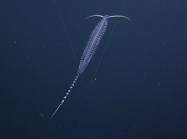RAS taxon details
Tomopteris Eschscholtz, 1825
129715 (urn:lsid:marinespecies.org:taxname:129715)
accepted
Genus
marine, brackish, fresh, terrestrial
recent only
feminine
Eschscholtz, Johann Friedrich von. (1825). Bericht über die zoologische Ausbeute während der Reise von Kronstadt bis St. Peter und Paul. <em>Isis von Oken.</em> 1825(6): 733-747, plate V., available online at https://www.biodiversitylibrary.org/page/27509188
page(s): 736 [details]
page(s): 736 [details]
Read, G.; Fauchald, K. (Ed.) (2025). World Polychaeta Database. Tomopteris Eschscholtz, 1825. Accessed through: RAS (Eds.) (2025) Register of Antarctic Species at: https://ras.biodiversity.aq/aphia.php?p=taxdetails&id=129715 on 2025-09-12
RAS (Eds.) (2025). Register of Antarctic Species. Tomopteris Eschscholtz, 1825. Accessed at: https://ras.biodiversity.aq/aphia.php/www.pfeil-verlag.de/04biol/www.pfeil-verlag.de/04biol/aphia.php?p=taxdetails&id=129715 on 2025-09-12
Date
action
by
original description
Eschscholtz, Johann Friedrich von. (1825). Bericht über die zoologische Ausbeute während der Reise von Kronstadt bis St. Peter und Paul. <em>Isis von Oken.</em> 1825(6): 733-747, plate V., available online at https://www.biodiversitylibrary.org/page/27509188
page(s): 736 [details]
basis of record Bellan, G. (2001). Polychaeta, <i>in</i>: Costello, M.J. <i>et al.</i> (Ed.) (2001). European register of marine species: a check-list of the marine species in Europe and a bibliography of guides to their identification. <em>Collection Patrimoines Naturels.</em> 50: 214-231. (look up in IMIS) [details]
additional source Day, J. H. (1967). [Errantia] A monograph on the Polychaeta of Southern Africa. Part 1. Errantia. British Museum (Natural History), London. pp. vi, 1–458, xxix., available online at http://www.biodiversitylibrary.org/bibliography/8596 [details]
additional source Fauchald, K. (1977). The polychaete worms, definitions and keys to the orders, families and genera. <em>Natural History Museum of Los Angeles County: Los Angeles, CA (USA), Science Series.</em> 28:1-188., available online at http://www.vliz.be/imisdocs/publications/123110.pdf [details]
page(s): 736 [details]
basis of record Bellan, G. (2001). Polychaeta, <i>in</i>: Costello, M.J. <i>et al.</i> (Ed.) (2001). European register of marine species: a check-list of the marine species in Europe and a bibliography of guides to their identification. <em>Collection Patrimoines Naturels.</em> 50: 214-231. (look up in IMIS) [details]
additional source Day, J. H. (1967). [Errantia] A monograph on the Polychaeta of Southern Africa. Part 1. Errantia. British Museum (Natural History), London. pp. vi, 1–458, xxix., available online at http://www.biodiversitylibrary.org/bibliography/8596 [details]
additional source Fauchald, K. (1977). The polychaete worms, definitions and keys to the orders, families and genera. <em>Natural History Museum of Los Angeles County: Los Angeles, CA (USA), Science Series.</em> 28:1-188., available online at http://www.vliz.be/imisdocs/publications/123110.pdf [details]
 Present
Present  Inaccurate
Inaccurate  Introduced: alien
Introduced: alien  Containing type locality
Containing type locality

